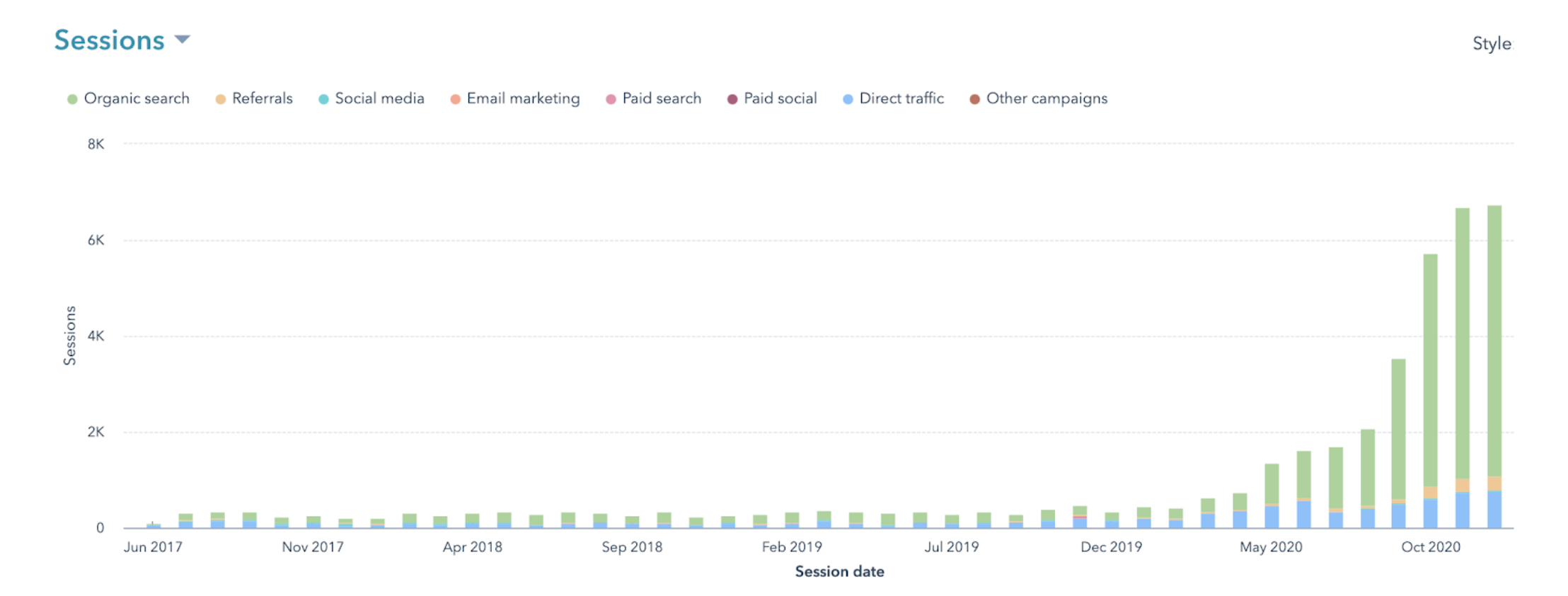Subscribe now and get the latest podcast releases delivered straight to your inbox.
Inbound marketing strategy for businesses (in 7 steps)
- Establish your goals
- Learn about your audience
- Build your team
- Develop a content strategy
- Get to work
- Evaluate, measure, adjust
- Branch out and try new things
The premise behind inbound marketing is simple: You can attract would-be customers to your website with valuable content.
Once there, they can learn about your company and your offerings, and they can become a customer — all without you having to run TV ads, radio spots, or billboard ads. You shouldn’t even need to pay for social media or search engine advertising.
The right content will attract organic traffic (that is, the traffic you don’t have to pay for) by ranking high in search engine results for terms and keywords related to your business.

Although it sounds pretty straightforward, the execution can be intricate and involved. A high rank for an important search term is a coveted position, so you’re likely not the only one vying for the top spot.
Implementing a strategic approach to your content marketing is the surest way to know that your efforts are well spent and likely to deliver results. To start, you need an overarching framework.
Your inbound framework: They Ask, You Answer
Without a clear structure, inbound marketing can feel like a vague set of principles. They Ask, You Answer is a proven inbound framework that unites your marketing and sales efforts around a single question: What does my buyer want to know?
If you approach your entire inbound marketing strategy with this question in mind, you’ll always be on the right path. To learn more about how They Ask, You Answer can unify your approach to marketing and sales, use our resource center.
Remember, a marketing strategy is important, but if it’s not aligned with a sales strategy and with your business goals, it’s unlikely to deliver results.
For now, though, here are the steps to build an inbound marketing strategy.
How to build an inbound marketing strategy in 7 steps
For the modern buyer, inbound content should include both written and video content. Here we’re mostly focused on written content, but the same steps and processes can be applied to video production as well.
What follows is a basic overview that you can use to build an inbound marketing strategy.
If you get started and find yourself stuck, reach out to one of our advisors or join our free education community. We help businesses like yours succeed with inbound marketing. Although you certainly can do it alone, you certainly don’t have to.
Step 1: Establish your goals
You can’t evaluate your own success if you don’t know what that success looks like. For this reason, the first step is establishing goals. Just like with any marketing initiative, you need to think about what you’re trying to accomplish. Is it brand awareness? More qualified leads? Increased revenue?
Inbound marketing can be employed across your customer’s buying experience, but to do so requires a coordinated effort and a great deal of content. If you’re a small team or are just starting out, focus on a few high-priority goals rather than many goals at once.
Do this first: Work with company leadership to determine the most important goals your inbound marketing is hoping to accomplish. Evaluate your current circumstances and establish where you’d like to be in 12 months. Then, make quarterly or monthly plans that get you there.
For example:
|
Current traffic |
500 website visitors per month |
|
Traffic goal |
3,000 website visitors per month |
|
Quarter 1 |
Planning, strategy, and ramp-up |
|
Quarter 2 goal |
1,000 |
|
Quarter 3 goal |
2,000 |
|
Quarter 4 goal |
3,000 |
Then, you can start putting in place the plans and tactics that can move you toward your goals.

Avoid: Spreading yourself too thin. It’s hard to fight several battles at the same time. If your goal is traffic and brand awareness, put your focus there. If you’re looking to provide sales-enablement materials that will help you close deals but won’t get clicked often, put your focus there.
Avoid focusing on statistics that don’t relate to what you’re trying for. If a piece of content helps close a sale but doesn't get traffic, it’s still a huge win, but only if you’re measuring the right metrics.
Pro tip: There’s nothing wrong with adjusting your goals. If you’re just starting out, you might not know what a realistic goal is. Therefore, set both short-term and long-term goals, knowing you can amend as needed. Even if you need to adjust them later, having goals is essential.
🔎 Related resource: How to come up with marketing goals based on business goals
Step 2: Learn about your audience
How do potential customers find you? It starts by knowing what they’re searching for. Keyword research can show you what the hot search terms are in your industry, as well as how competitive the search landscape is. You can learn about how your competition ranks so you can best channel your efforts.
At IMPACT, we use several tools to do this, but Google Search Console and Semrush are our go-to favorites. They are both pretty intuitive, but you’ll need to spend some time learning the ropes.
The internet generates unfathomable amounts of data, and these platforms help organize it. Even so, it’s easy to be overwhelmed by everything you find. There are online tutorials that can walk you through what you need to know.
Do this first: Use a tool such as Semrush to do keyword research. The free version limits the number of searches you can do; paid plans start at $119 per month, but there is a free trial to get started.
Avoid: Focusing on the wrong things. Website traffic is great, but it can be a vanity metric. You could produce a piece of content that ranks high and drives a ton of traffic, but if those site visitors don’t have purchasing intent, it won’t impact your bottom line.
For example, you could rank for Best games to play in your backyard this summer, but if what you sell is insurance, it’s unlikely many of those visitors will convert.
Pro tip: Perhaps the best resource for learning about your customers is your sales team. They speak with buyers every day. They know what they’re asking, what they're concerned about, and what ultimately makes them decide to purchase. Schedule time to brainstorm content topics with your sales team.
🔎 Related: Intent research vs. keyword research: Planning your SEO strategy
Step 3: Build your team
Someone actually has to be doing the writing and video production. You basically have three options, all with pros and cons.
At IMPACT, we recommend hiring an internal team because it’s more efficient, cheaper, and produces higher quality, but this option has its drawbacks as well.
|
Hiring an agency |
Pros: Quick to start, a good level of expertise. Cons: Expensive and inefficient (you’ll likely get two or three articles per month); often produces fluffy content that doesn’t sound like you and doesn’t bring in qualified traffic. |
|
Hiring a freelancer |
Pros: Inexpensive, fairly quick to start, some level of expertise. Cons: A mixed bag in terms of quality; freelancers often write as a side hustle, so getting a response during business hours can be hard; reliability can be a problem. |
|
Hiring an internal content team |
Pros: You have full-time access, which means more content, quicker turnarounds, and good relationships between the content producers and the team. Cons: You have to find and hire the right person — and onboard them to your company. |
Do this first: Figuring out who is going to write your content is a critical question that must be answered before you move forward. The three options above represent three different paths. You’ll need to choose one.
Avoid: Not planning for the future. Don’t just think about the short term. While it’s tempting to value the options that represent a quicker start, realize that hiring an agency, for example, will limit your output and cost you much more in the long run. Inbound marketing is a long game. Plan accordingly.
Pro tip: When hiring a writer (freelance or in-house), you don’t need to look for industry experience. In fact, an outsider’s perspective could be very valuable in your content.

Sometimes an industry insider can get bogged down with jargon and specifics that don’t suit your buyers.
🔎 Related: Your inbound content writer doesn’t need industry experience: Here’s what to look for instead
Step 4: Develop a content strategy
Once you have your goals, your research, and your team, you now need a plan for actually doing the work.
Content writing involves a lot more than just writing. It’s keyword research, brainstorming meetings, building reports, evaluating and updating older content, and more.
For your inbound marketing to be successful, you’ll need to plan how all of this gets done. This means building processes and creating a clear meeting cadence.
Do this first: Develop a clear process that can track each piece of content from inception to publication (and beyond). Determine who is responsible for each step. If you’ve hired a content writer, that person should be able to handle most aspects, but a second set of eyes for editing, at least early on, would be good.
Avoid: Role creep. Don’t let your writer get pulled in too many directions. If you have hired a person to write your content, avoid piling too much else on his plate so that content production suffers.
Things like social media management, email campaigns, and copywriting can be full-time jobs on their own. Asking too much can lead to burnout.
Pro tip: Figure out a publication cadence that is realistic for you and plan accordingly. Don’t try to commit to three articles per week if you won’t be able to keep that up. At any time, you should have content in various stages of the creation process: a backlog of ideas, outlines, drafts, and finalized, proofed work. This keeps the whole thing moving.
🔎 Related: What is a content strategy? (definition + examples)
Step 5: Get to work
Bill Gates famously said that most people overestimate what they can do in one year and underestimate what they can do in 10 years. There’s no way around it: inbound marketing can be a lot of work. Building a library of valuable content for your audience takes time.
At IMPACT, we advise our clients to publish two or three new articles each week. If you’re able to keep this pace up for a year, you’ll have over 100 articles.
Do this first: Review SEO best practices to make sure your content is most likely to be found in search. There are great checklists you can use to make sure you’re not missing anything.
Avoid: Bottlenecks. Bottlenecks are content killers. Avoid having the need for multiple company leaders to sign off on every piece of content that gets published. Doing so will only slow you down. While it’s critical to have a great editor and a solid QA process, content can languish on the virtual desks of busy company leaders who don’t have the time to double-check three articles every week.
Pro tip: Build a content calendar that ensures regular publication. Develop a backlog of content needs and sort them by priority. Use Trello or another tool to keep track of your progress.
🔎 Related resource: 7 biggest reasons your inbound marketing is failing (and how to fix them)
Step 6: Evaluate, measure, adjust
We recommend using HubSpot to track and evaluate your inbound marketing. With packages ranging from free to enterprise-level, there are options for every budget. HubSpot offers custom reporting options that provide granular insight into blog performance — everything from traffic analysis to revenue attribution.
Do this first: Learn your way around HubSpot so you know what you’re looking for. Evaluating the effect of a single piece of content can be tricky. Here’s a video from HubSpot explaining the different attribution models they use.
Suffice it to say, the customer journey is rarely simple and linear. Your content might not play the exact role you expect. HubSpot lets you measure results in new and exciting ways.
Avoid: Getting too focused on small changes. Don’t get hung up on small fluctuations. The internet can be a fickle place. You’re going to have good weeks and bad weeks. Try to zoom out from small fluctuations so you don’t hit the panic button for no reason.
Pro tip: As you start to build a hefty library of content, you’ll have to devote some of your time to updating and optimizing older content so it keeps performing well. Once you’re firing on all cylinders, our content trainers recommend spending a third of your time updating older content.
🔎 Related resource: Content ROI examples: How to nail your reporting with HubSpot
Step 7: Branch out and try new things
If you’ve got the basics down and a good head of steam, it’s not time to rest on your laurels. What are other ways you can use inbound marketing to help your organization? Some practical and prudent next steps could be:
-
- Starting a newsletter to share new content with your audience.
- Building a social media strategy to connect with customers and fans.
- Creating email sequences that trigger when a prospect completes certain actions.
- Expanding your video strategy to drive YouTube engagement.
- Producing a buyers’ guide to help answer prospect questions before purchase.
- Creating post-sale content to keep your customers happy and engaged.
As with anything related to inbound marketing, think creatively about the needs of your customers and the strengths of your team. What will help you get found or help your prospect become a customer?
At the same time, keep learning all you can. Sign up for IMPACT+ and take free courses. Utilize HubSpot Academy’s certification programs. Listen to podcasts. Read newsletters.
🔍 Related: 5 Key Elements of a Winning Inbound Marketing Strategy
Now the fun begins
An inbound marketing strategy could be executed by a team of dozens, with demand generation, content creation, videography, strategy, and more — or it could be done by a single entrepreneur trying to support her side hustle.
In either case, the process follows a similar path. Know what you’re trying to do, find the right people to do it (even if it’s you), and get going. Building momentum is crucial. That way, you’ll actually have something to measure. Then, you can take stock, pat yourself on the back, and adjust your course forward.


Order Your Copy of Marcus Sheridan's New Book — Endless Customers!

